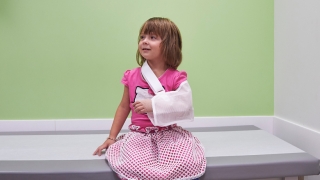Snapping Hip Syndrome in Children and Teens
What is snapping hip syndrome?
Snapping hip syndrome is a condition characterized by a “snapping” or popping sensation in the hip or groin. Patients with the syndrome often hear an audible snapping sound and feel a snapping sensation at the hip or groin. The sound or sensation can occur with or without pain; and can affect one hip or both.
Snapping hip most commonly occurs when a tendon (which works to attach muscle to bone) “catches” or get stuck over a bony prominence or structure deep inside the hip joint. This most commonly affects the hip flexor tendon in the front of the hip/groin or the IT (iliotibial) band on the outside of the hip. In less common situations, snapping hip syndrome can occur due to a torn labrum, the rim of cartilage that lines the ball and socket joint of the hip.
Snapping hip syndrome – medically referred to as coxa saltans – can affect people of all ages and genders, but is more common in young, active female athletes such as dancers who continue to practice or train through the pain or discomfort. As many as 90% of ballet dancers report experiencing snapping in one or both of their hips.
Types and causes of snapping hip syndrome
There are three primary types of snapping hip syndrome:
- External – occurs when the iliotibial (IT) band, a tendon that runs down the side of the leg, slides over the top of the femur and catches momentarily. This happens on the side of the hip. This is the most common type of snapping hip syndrome.
- Internal – occurs when the hip flexor tendons slide and catch over bony structures at the front of the hip joint. The snapping occurs most commonly when the individual is moving from a bent to straight position and the flexor muscle stretches and gets caught momentarily on the hip bone before snapping back into place. This is the second most common form of snapping hip syndrome.
- Intra-articular – occurs due to a hip joint injury. The most common intra-articular issues include:
- an injury to the articular cartilage that lines the ball and socket of the hip
- an acetabular labral tear (the cartilage that rims the hip socket)
- broken bone fragments or floating debris that becomes trapped in the hip’s ball and socket joint after a fracture or dislocation of the hip
Groups at highest risk of snapping hip syndrome include females, young adults with recent growth, and athletes who use the same muscles repeatedly such as soccer players, runners and those who participate in gymnastics and dance.
Symptoms of snapping hip syndrome
As its name indicates, snapping hip syndrome can include an audible snapping or clicking sound. While the condition often causes no pain, individuals with the disorder may feel a clicking or popping sensation when flexing their hip.
Other symptoms of the syndrome may include:
- Inflammation
- Swelling
- Muscle weakness when trying to lift the leg
- Discomfort or unease – feeling the hip is about to come out of its place
- Difficulty with routine physical activity
- Pain
Snapping hip syndrome in dancers
Symptoms are more common with certain ballet positions such as:
- Grande battement à la seconde (a high kick to the side with a straight leg)
- Grand plié (a deep knee bend)
- Développé à la seconde (a slow extension of the leg from a flexed and turned-out position)
Testing and diagnosis of snapping hip syndrome
Snapping hip syndrome is generally diagnosed clinically. At Children’s Hospital of Philadelphia (CHOP), an orthopaedic physician or sports medicine specialist will examine your child’s medical history, evaluate their symptoms and perform a physical examination. In some cases, imaging tests may be ordered to confirm or pinpoint any injury within the hip joint itself.
Imaging tests may include:
- X-rays to allow for full visibility of bones and joints.
- MRI scan and/or MR arthrogram to identify injury within the hip joint and rule out other more serious or persistent disorders including hip joint synovitis (inflammation of the lining of the hip), hip arthritis (which is rare in children), and tumors (also rare in youth).
- EOS X-ray imaging, a low dose, 3-D imaging technique that scans patients in natural standing positions. This test can be helpful to see how the ball and socket of the hip fit together.
Snapping hip syndrome treatment
In many cases, snapping hip syndrome will not require medical treatment. If the condition causes pain, your child’s doctor may recommend:
- Rest and limiting physical activity to allow muscles and tendons to heal.
- Using ice or a cold compress to ease pain and inflammation.
- Over-the-counter medicines – such as ibuprofen or naproxen to reduce inflammation and treat minor pain.
- Ultrasound-guided corticosteroid injection, administered by a healthcare professional, to inject anti-inflammatory medication into the affected area. This treatment can offer pain relief, increase the patient’s range of motion and can be used as a window of opportunity to do more in physical therapy.
- Physical therapy, massage and guided exercise to stretch and strengthen hip and core musculature, improve flexibility and provide greater control and stabilization within specific movements.
- Rehabilitation may include modification of specific movements to allow pain to decrease while still allowing the youth to participate in daily activities like sports or dance.
Physical or rehabilitation specialists may recommend guided snapping hip syndrome exercises, such as an iliotibial band stretch, hip flexor stretch, or supine (lying down) hamstring stretch.
In rare cases of snapping hip syndrome, nonsurgical treatments such as those listed above may not successfully relieve symptoms. In these cases, surgery may be recommended.
Surgical options for snapping hip syndrome include:
- Iliotibial band release, which involves lengthening the iliotibial band to reduce hip snapping and tension
- Iliopsoas tendon release, which involves lengthening the iliopsoas tendon to reduce muscle tension and decrease hip clicking.
- Arthroscopic hip debridement, which involves making a small incision at the hip joint to remove floating debris
Follow-up care for snapping hip syndrome
In most cases, snapping hip syndrome can be healed over time with rest, a daily exercise routine to improve muscle strength and flexibility and gradually increasing the intensity of workouts or sports activities.
To speed healing and prevent snapping hip syndrome from recurring, physicians and therapists often recommend the following exercises:
- Stretching the muscles on the front, side and back of the hip before any physical activity and repeating these stretches to cool down after strenuous activity such as a competition or performance.
- Increase the intensity of activity slowly. Don’t push too fast, too hard or too soon. Stop or pause activity that is causing pain.
- Participate in a variety of physical activities or different types of sports so the same muscles are not overstressed in the same way from repeated motions.
Outlook
The outlook for youth with snapping hip syndrome is generally positive and does not cause long-term damage. While most can be helped with nonsurgical interventions, some will require surgery. To ensure optimal outcomes for children with snapping hip syndrome, families should seek orthopaedic and sports medicine specialists who have the knowledge and expertise to provide whatever treatment is necessary for the youth to return to the activities they enjoy.



